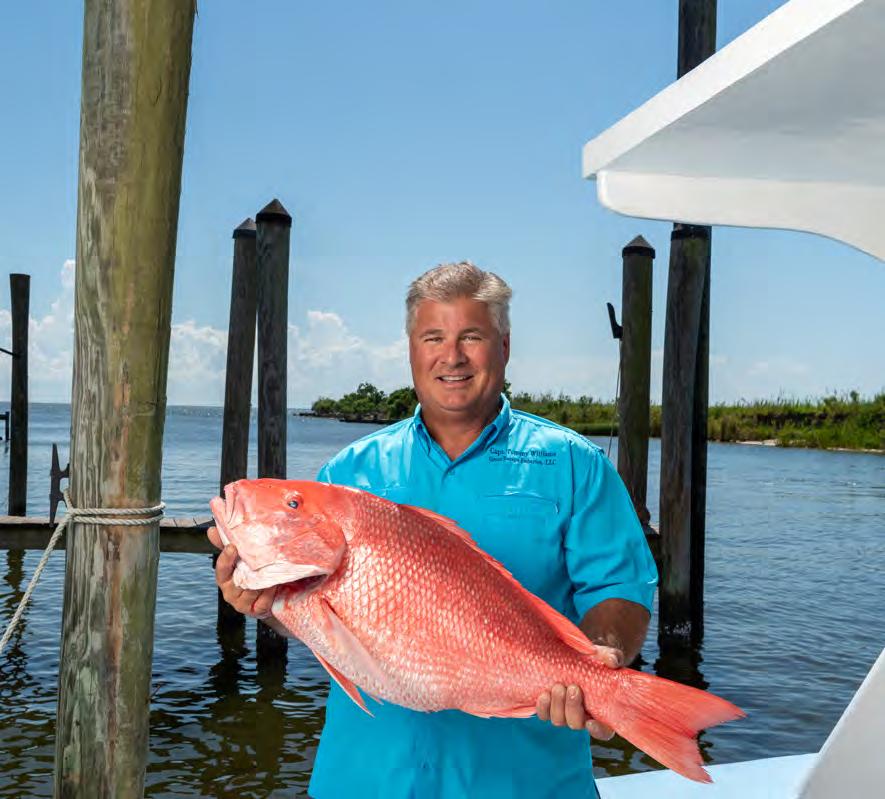
5 minute read
Some Fin to Talk About
By David W. Brown
For Rouses Markets, offering the best products, including seafood, at the lowest prices is everything. When you are talking about creatures harvested from the sea, to ensure quality, you have to go the extra mile and do things a little bit differently. The telltale signs are subtle but important, and how the seafood is handled every step of the way must be expertly done.
Seafood moves very quickly from the sea to your shopping cart, and along the way are several quality checks by the best in the business.
“The first thing is to know who you are buying from,” says Denise Englade, the Director of Seafood for Rouses Markets. The seafood group buys straight from the source to make sure Rouses sells only the freshest fish possible. To that end, Denise and her team work with producers, processors, and fishers directly.
“For the majority of our fish — especially our local fish — we buy it whole, and then we fillet it at the store level,” she says. This is important because when you get a whole fish that still has its scales and its skin and its belly lining (among its other parts), you are ensuring that the fish, first, stays fresher on the bone, and second, has the parts necessary to allow for a more in-depth inspection of its quality.
When the certified seafood experts at Rouses Markets get a fish, the first thing they do is look in the fish’s belly. “You want to make sure the belly bones, as we call them, and the belly wall, is fresh and the bones are poking through,” says Englade. Next, when the Rouses team member threads up the spine, he or she is looking for red blood — in other words, that it has not yet oxidized. For a head-on fish, the fish experts check its gills, which should also have nice, fresh, red blood. When the gills have turned brown, that means the fish has been around too long, and has begun oxidizing.
A lot of people pay special attention to the eyes of a fish to determine freshness — that cloudy eyes mean trouble — but Englade says that isn’t always true. A saltwater fish pulled from the Gulf would immediately be packed in ice, which would cause its eyes to be cloudy. Because the Rouses seafood team handles so many types of fish from so many sources, they have to be meticulous. Rather than looking at eye cloudiness, a fish inspector will look at eye concavity. Fish pulled from the sea, whether fresh or saltwater, might or might not have cloudy eyes, but a fresh fish would definitely have round and plump eyes. If the eyes are sinking in, that’s a sign of age.
In addition to the vendors checking the fish the moment it is received, each fish must again pass an inspection before it even makes it through the door of your local Rouses.
“We have receivers at the back of the store for all our incoming products, but that receiver is not allowed to receive seafood. They are required to call a seafood specialist to first take a look at that product and ensure that before we received it, that it meets our specifications,” Englade explains.
Some fish Rouses receives filleted before delivery, such as catfish, some Atlantic salmon, and tilapia, to name a few. To inspect them for freshness, the seafood specialists at every Rouses look at the boxes they come in to check for things like the process date and the day they were caught. Both vendors who help supply Rouses, and the Rouses team members themselves, are looking at that to ensure maximum freshness.
Once the fish makes it to the display cases in Rouses seafood departments, the teams track the date it arrived, and only the freshest seafood gets sold. Anything carried for too long is rotated out, as customers need time as well to take the fish home and store it before cooking it, which can sometimes be days later.
“We want to make sure that products are going fresh to our customer. On any given day, we have fresh seafood coming in so that the customer can feel confident that what they are buying is quality, fresh seafood,” she explains.
Every Rouses has the same core seafood items — basically any seafood you can think of off the top of your head: head-on shrimp, peeled shrimp, catfish, tuna, scallops, among many others. On top of that, stores stock fish that happen to be caught at any given time; it might be drum or sheepshead or speckled trout or rockfish.
“In the world of seafood, it’s day to day,” says Englade. “Just because something is in season doesn’t mean someone is going to catch it.” Weather conditions, rain, hurricanes — those problems can be unrelenting. And when that happens, Englade and her team never rest on their laurels. “We are aggressive and we will have the best products of anyone out there. We will have the availability. We do that by building relationships with our vendors and fishermen.”
And any seafood that Rouses doesn’t carry, but that can be commercially fished, is available for special order with 48 hours’ notice.
Englade says it is fun to introduce new seafood from other areas to Rouses customers. “We keep true to our local fishermen, making sure that we’re working with the fishermen, crawfish farmers, and our shrimp guys in the area. And we make sure that while we’re supporting local, we are also offering seafood from all over. And that’s really is my passion. And I do love it.”










